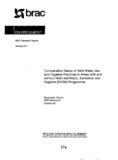Comparative status of safe water use and hygiene practices in areas with and without NGO-Ied Water, Sanitation and Hygiene (WASH) Programme
Citation
Ghosh, S. C., Ali, A. M., & Arif, T. (2011, January). Comparative status of safe water use and hygiene practices in areas with and without NGO-Ied Water, Sanitation and Hygiene (WASH) Programme. Research Reports (2011): Health Studies, Vol - XLIII, 75–100.Abstract
More than 90% people in Bangladesh have access to improved water supply system,
but arsenic is posing a threat to this achievement. Additionally, hygiene is considered
as one of the challenging areas to deal in the development sector. A number of
organizations (both government and non-goverment) are working to improve the water
supply, sanitation and hygiene practices through various water, sanitation and hygiene
programmes.
OBJECTIVE
The overall objective of this study is to reveal the role of non-government
organizations (NGOs) in improving safe water use and hygiene practices by the rural
people of Bangladesh.
METHODS
Ten upazi/as with both NGO-Ied sanitation programme intervention and without any
such activity (Comparison group) were selected for the study. Among the study
upazilas, four were comparison upazilas, three were with BRAC facilitated WASH
programme intervention areas and the rest three were with other NGO-Ied intervention
areas. A multistage 30-cluster sampling method was adopted and 420 households
were selected randomly from every upazila for the survey. In selecting 30 villages from
every upazila, interval-sampling method was used.
KEY FINDINGS
1. Tubewell water was used predominantly for drinking in the study areas.
Significantly higher proportion of households in the BRAC WASH areas used
tubewell water for drinking than the comparison and other NGO intervention
areas (p<0.001).
2. The expenditure for tubewell drilling was mostly covered by self arrangement
(95.1 %) in the study areas. However, in BRAC WASH intervention areas 1.2%
and in other NGO-covered areas 1.1 % tubewells were financed by NGOs.
Households not having their own tubewell mentioned financial problem (90.8%)
as the major reason for not being able to install tubewell.
3. Overall knowledge about the demerits of using arsenic-contaminated water in the
comparison areas was found less than the NGO-Ied WASH intervention areas.
Regardless of the NGO-facilitated WASH programme prevalence, social
institutions (54%), NGOs (23.5%) and mass media (26.6%) were the most
common sources of information for knowing the demerits of using arseniccontaminated
water.
4. Significantly higher proportion of people in NGO intervention areas (either BRAe
or other NGOs) mentioned to wash hands during critical times than the
comparison areas. The overall hygiene practice among the households in the
other NGO intervention areas with regard to all relevant issues was found higher
than the BRAe WASH and comparison areas, since less proportion of
respondents mentioned not to know about the hygiene issues (p<O.001).
5. Respondents from all intervention areas strongly opined for the necessity of
NGO-Ied WASH programme for the improvement of safe water use (95.1%) and
hygiene (95.8%) practices.
6. While asked about the source of information regarding safe water use and
hygiene practices social institution and mass media were found predominant
among all intervention areas. However, in areas with WASH programme
intervention the respondents also mentioned NGO as a major information source.
CONCLUSIONS
The overall status of use of tubewell water and hygiene practices was found better in
the NGO-Ied WASH intervention areas than the comparison areas. People mentioned
about the effects of NGO interventions on the improvement of use of safe water and
hygiene practices through the support for tubewell installation, arsenic testing,
motivation and raising awareness through the village level committees organized by
the NGOs. Majority of the respondents mentioned about the necessity of NGO
intervention for ensuring 100% safe water use and hygiene practices. However, it
needs more support (both tubewell supply and awareness activities) from

